
That's a hell of a thing to ask
Dambusters bomb-aimer, Johnny Johnson, explains the difficulties of dropping bombs at low heights and how they led to the introduction of spotlights on the aircraft.
According to Johnny, when Barnes Wallis asked Wing Commander Guy Gibson if he could drop the bomb at not 150ft but just 60ft, he responded, "Well, that’s a hell of a thing to ask but we’ll try it and see."
Johnny went on to explain the difficulties of dropping bombs at such a low height, not just for the crew’s safety but also for the technical ability of the aircraft.
"Any question of getting the actual height became a nuisance because the altimeters, although they were good, weren’t accurate to that particular degree and the pilot was going to be concerned with other things rather than just watching his altimeter."
A new way of knowing when the height of the aircraft reached exactly 60 feet had to be devised and so the famous spotlight guiding system was created.
"The boffins at Farnborough fitted two Aldis lamps to the fuselage of the aircraft," says Johnny, "One midway along the fuselage the other one nearer the nose and they were angled specifically so that they converged at exactly 60ft."
"The whole practice became a complete crew operation which meant the pilot for once was having to do as he's told by three different members of crew!"
This blog is dedicated to the memory of Warrant Officer Alden Cottam, a flight engineer with 617 Squadron on the Dambuster raid, who was killed in action.